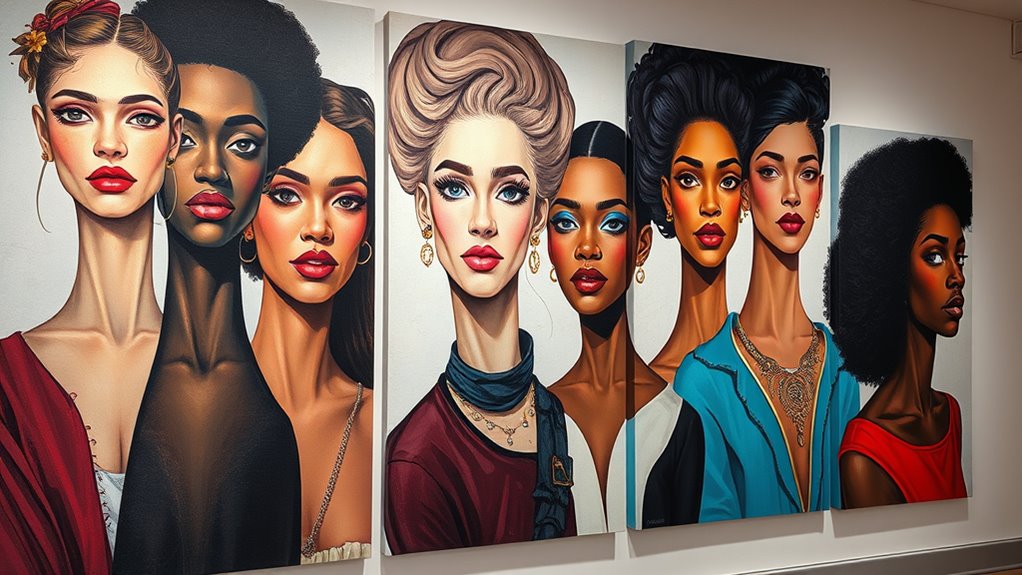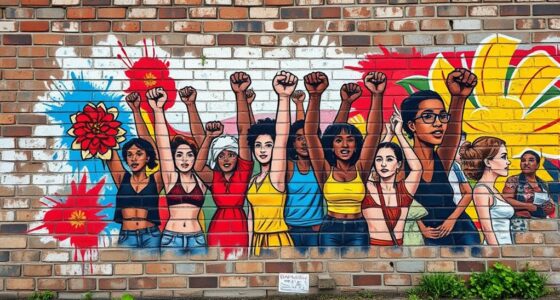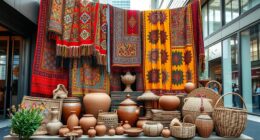Contemporary art challenges traditional gender stereotypes by showcasing authentic, complex identities and promoting inclusivity. Artists question long-held roles, highlighting marginalized voices and pushing social norms through provocative imagery and diverse media. They explore intersections of gender with race, class, and sexuality, revealing how societal expectations shape our views. This movement encourages you to rethink perceptions and appreciate gender as a fluid spectrum. Keep exploring to discover how these powerful artworks influence societal understanding and acceptance.
Key Takeaways
- Contemporary art challenges traditional gender stereotypes, portraying authentic and complex identities beyond societal expectations.
- Artists highlight marginalized voices, using art as a political platform to question dominant narratives around gender.
- Diverse mediums like performance, mixed media, and symbolism are employed to critique and dismantle gender norms.
- Art explores intersections of gender with race, class, and sexuality, emphasizing gender as a social construct.
- These works promote inclusive dialogue, encouraging societal reflection on gender perceptions and fostering acceptance of diverse identities.

Gender representation in contemporary art has become a vital conversation, revealing how artists challenge traditional roles and push for greater diversity. You might notice that many artworks now question long-standing gender stereotypes, breaking away from the narrow confines society once imposed. Instead of portraying men and women in stereotypical ways—women as delicate or submissive, men as strong and dominant—artists are exploring more authentic, complex identities. They use their work to confront how gender roles have historically limited individuals, encouraging viewers to rethink preconceived notions about what it means to be masculine or feminine. This shift is often driven by an awareness of identity politics, where artists intentionally highlight marginalized or underrepresented voices to challenge dominant narratives. Through their art, they advocate for a broader understanding of gender as a spectrum, moving beyond binary classifications and emphasizing individuality.
You may find that contemporary artists are deliberately dismantling stereotypes by using provocative imagery, mixed media, or performance art to question societal norms. They’re not just making aesthetic statements but engaging in political dialogue, urging audiences to consider how gender intersects with race, class, and sexuality. Their work often serves as a platform for marginalized groups, amplifying their stories and experiences that might otherwise be ignored or misunderstood. By doing so, they push the boundaries of traditional art forms and expand the conversation around gender, making it more inclusive and nuanced. This approach encourages you to reflect on your own perceptions and biases, recognizing that gender identity isn’t fixed or simple but fluid and multifaceted.
In this context, gender stereotypes are actively challenged through visual storytelling that emphasizes personal narratives and collective histories. Artists scrutinize how societal expectations shape behavior and identity, often exposing the restrictive nature of gender norms. Their work reveals that gender is not just a biological fact but also a social construct that can be deconstructed and reshaped. You might see this reflected in artworks that incorporate symbols, language, or performance elements meant to evoke dialogue about gender equality and rights. Such efforts foster a more inclusive artistic landscape where diverse identities are recognized and celebrated, encouraging you to think critically about the roles assigned to you and others. Overall, contemporary art offers a powerful space to confront gender stereotypes and explore the richness of human identity, pushing society toward greater acceptance and understanding.
Frequently Asked Questions
How Has Gender Representation Evolved Over the Last Century?
Over the last century, you’ve seen significant shifts in gender representation, moving from stereotypical roles to more complex, diverse portrayals. Historical shifts challenged traditional gender symbolism, empowering artists to explore identity beyond binaries. You now witness more female and non-binary artists gaining recognition, breaking down previous barriers. This evolution reflects society’s growing awareness of gender nuances, fostering a richer, more inclusive artistic landscape that celebrates individual expression and challenges outdated stereotypes.
What Role Do Art Institutions Play in Promoting Gender Diversity?
Art institutions play a pivotal role in promoting gender diversity through inclusive curatorial practices and targeted funding initiatives. You can see them actively choosing diverse artists for exhibitions, ensuring visibility for underrepresented groups. By allocating resources to gender equity projects and supporting female and non-binary artists, institutions foster a more equitable art world. Your support for these initiatives helps sustain ongoing efforts to challenge gender biases and promote diversity.
Are There Specific Art Movements Focused on Gender Issues?
Imagine a vibrant garden where feminist art blooms alongside other flowers, symbolizing gender activism’s growth. Specific art movements like feminist art focus on gender issues, challenging norms and inspiring change. These movements act as seeds of awareness, encouraging dialogue and activism. By nurturing gender issues through bold visual statements, they transform the landscape of contemporary art, making it more inclusive and reflective of diverse voices.
How Do Audience Perceptions Influence Gender Narratives in Art?
Your audience’s biases and perception shifts markedly shape gender narratives in art. When viewers bring preconceived notions, they may interpret works differently, reinforcing stereotypes or challenging them. As perceptions evolve, they can open up new conversations about gender, encouraging artists to push boundaries. Your role as an observer influences this dialogue, making your understanding and openness essential in transforming how gender stories are conveyed and received in contemporary art.
What Challenges Do Non-Binary Artists Face in the Contemporary Art Scene?
As a non-binary artist, you often face challenges maneuvering identity politics and gaining acceptance in an art scene that still favors traditional binaries. You might struggle to find inclusive spaces that genuinely celebrate your unique perspective, and you’re often overlooked or misrepresented. Despite these hurdles, you push boundaries, advocating for visibility and authenticity, creating work that challenges norms and fosters greater understanding in the contemporary art world.
Conclusion
Imagine the art world as a vibrant garden, where every flower adds its unique color and fragrance. When gender representation flourishes, the garden becomes more beautiful and balanced. But if certain flowers are kept in the shadows, the entire landscape loses richness. By actively nurturing diversity, you help guarantee this garden blooms with equal opportunity and creativity. Embrace your role as a gardener, cultivating a space where all voices can thrive and contribute to the masterpiece.









